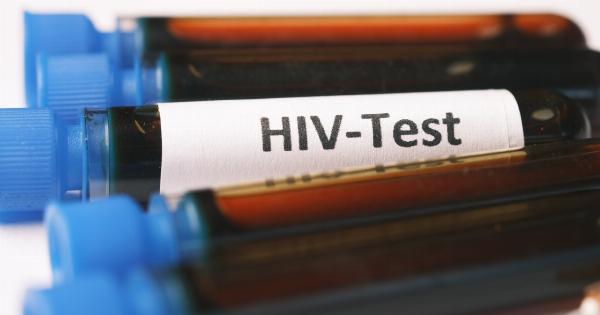Human Immunodeficiency Virus, commonly known as HIV, is a global health crisis that affects millions of people around the world. Since its discovery in the early 1980s, HIV has posed significant challenges to both individuals and public health systems.
However, with advancements in medical research and treatment options, living with HIV has become more manageable, allowing individuals to lead long and productive lives.
The Importance of Early Diagnosis
When it comes to HIV, early diagnosis is crucial. Detecting the virus at an early stage allows individuals to begin treatment promptly, which significantly improves their prognosis and quality of life.
Unfortunately, many people unknowingly live with HIV for years without symptoms, making it essential to encourage regular testing and raise awareness about the importance of getting tested.
Early diagnosis not only benefits the infected individuals but also prevents further transmission of the virus.
With the appropriate treatment, people living with HIV can achieve an undetectable viral load, which means they cannot transmit the virus to their sexual partners. Timely initiation of treatment is essential to reach this stage and reduce HIV transmissions.
The Evolution of HIV Treatment
In the early days of the HIV epidemic, treatment options were limited, and the prognosis was grim. However, over the years, tremendous progress has been made in the field of HIV treatment.
Antiretroviral therapy (ART) revolutionized the management of HIV by effectively suppressing viral replication and allowing the immune system to recover.
ART consists of a combination of different medications designed to target the various stages of the HIV life cycle.
By interrupting the viral replication process, ART can reduce the viral load in the body, preserve immune function, and delay disease progression. With advancements in medication, the treatment regimens have become more convenient, with fewer side effects and higher efficacy.
Benefits of HIV Treatment
The benefits of HIV treatment extend far beyond the individual’s health. By suppressing viral replication, ART prevents the progression of HIV to Acquired Immunodeficiency Syndrome (AIDS), a condition characterized by severe immune system impairment.
This not only improves the quality of life for individuals living with HIV but also reduces healthcare costs associated with managing AIDS-related complications.
HIV treatment also plays a vital role in reducing HIV-related stigma. In the early days of the epidemic, HIV was perceived as a death sentence, and people living with the virus faced significant discrimination.
However, with effective treatment options available, individuals can live healthy lives and contribute to society like anyone else, challenging misconceptions and breaking down barriers.
The Importance of Adherence to Treatment
Adherence to HIV treatment is crucial for long-term success. Consistently taking medication as prescribed can maintain viral suppression, prevent drug resistance, and minimize the risk of disease progression.
Non-adherence, on the other hand, can lead to treatment failure, increasing the chances of developing drug-resistant strains of HIV and limiting future treatment options.
Healthcare providers and support networks play a crucial role in promoting adherence to HIV treatment. They provide educational resources, counseling, and reminders to help individuals remain committed to their treatment regimen.
Adherence to treatment not only benefits the individual but also helps prevent the emergence of drug-resistant HIV strains, safeguarding public health.
Addressing Barriers to HIV Treatment
Despite the advancements in HIV treatment, several barriers exist that hinder access to care for many individuals. Some of the common barriers include:.
1. Stigma and Discrimination
The stigma surrounding HIV remains a significant barrier to treatment access. Fear of discrimination and judgment prevents many individuals from seeking testing and treatment services.
To address this barrier, public health campaigns and educational programs must focus on reducing HIV-related stigma, fostering acceptance, and promoting empathy.
2. Limited Resources
In many regions, especially in low- and middle-income countries, limited resources pose a significant challenge to HIV treatment access.
Insufficient healthcare infrastructure, lack of trained healthcare professionals, and high medication costs can hinder individuals from receiving the care they need. Global efforts must prioritize increasing funding for HIV programs and improving healthcare infrastructure.
3. Lack of Awareness and Education
It is crucial to raise awareness about HIV, its modes of transmission, and the available treatment options. Many people, especially in communities with higher rates of HIV infections, lack accurate information about the virus and its management.
Educational campaigns should be targeted towards these communities to ensure comprehensive understanding and encourage testing and treatment seeking behaviors.
4. Geographical and Social Disparities
HIV treatment access varies significantly across different geographical regions and social groups. Rural areas, marginalized populations, and certain demographics face additional barriers to HIV care.
Efforts should be made to improve access in underserved areas and eliminate inequalities in healthcare delivery.
The Future of HIV Treatment
As medical research continues to progress, the future of HIV treatment looks promising. Scientists are exploring novel approaches, such as long-acting antiretroviral drugs, vaccines, and gene therapy, to further improve treatment outcomes.
Additionally, ongoing research aims to develop a cure for HIV, which would eliminate the need for lifelong treatment.
Conclusion
HIV treatment plays a critical role in managing the virus, improving the quality of life for individuals living with HIV, and preventing further transmission.
Early diagnosis, initiation of treatment, and adherence are vital aspects of successful HIV management. By addressing barriers to treatment access and investing in healthcare infrastructure, we can ensure that all individuals living with HIV receive the care they need.
With continued advancements in treatment options and ongoing research, we move closer to a future free from HIV/AIDS.

























